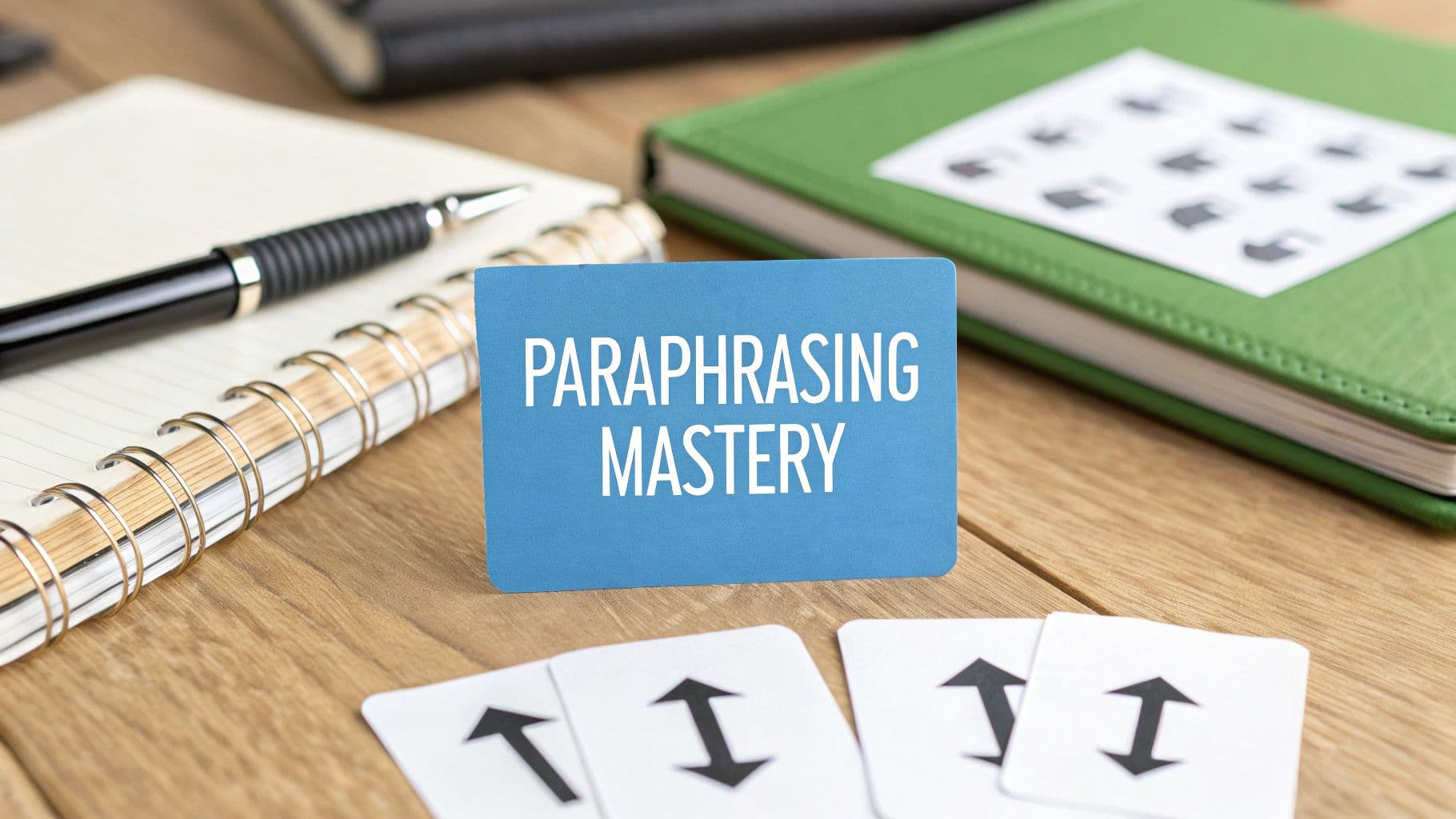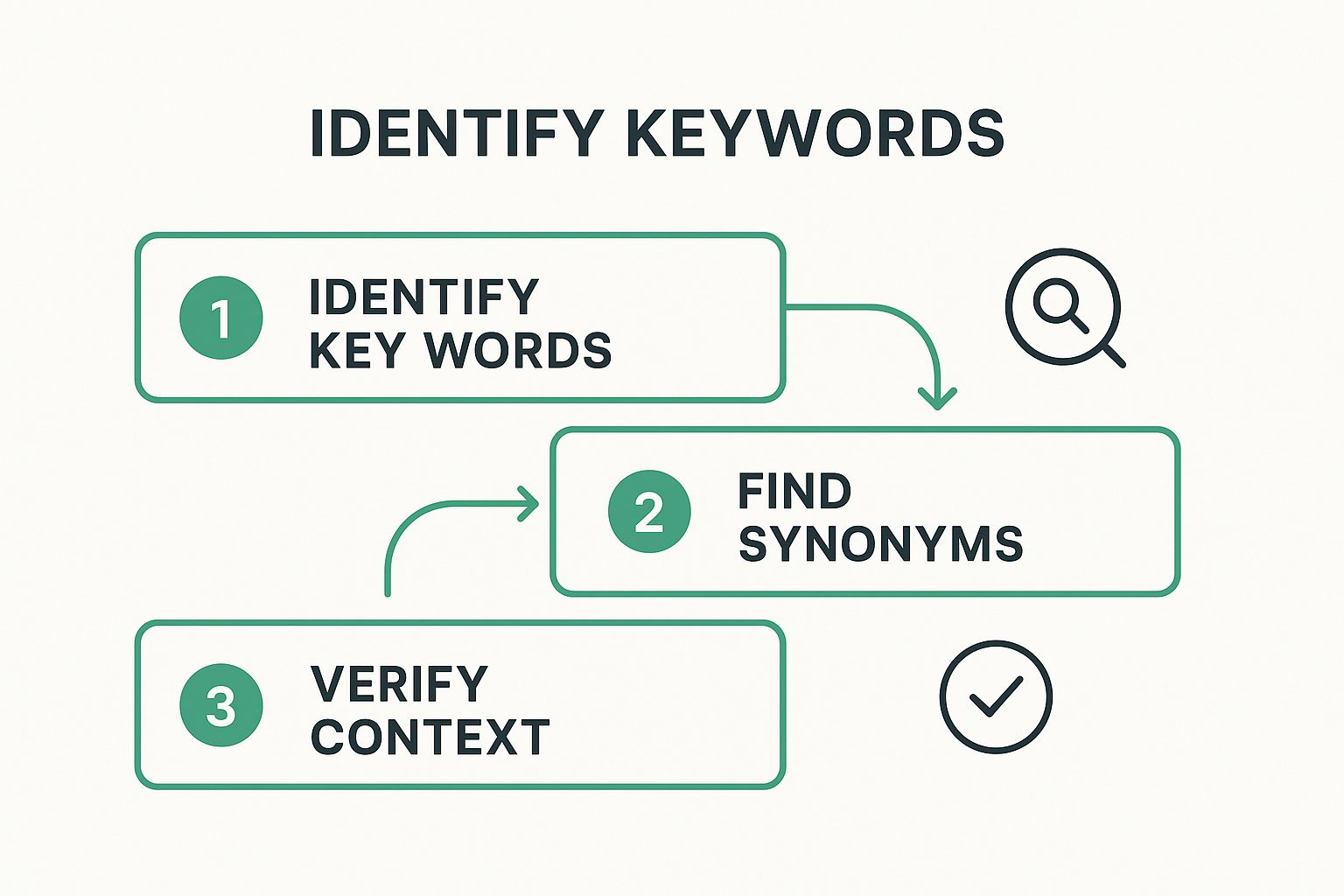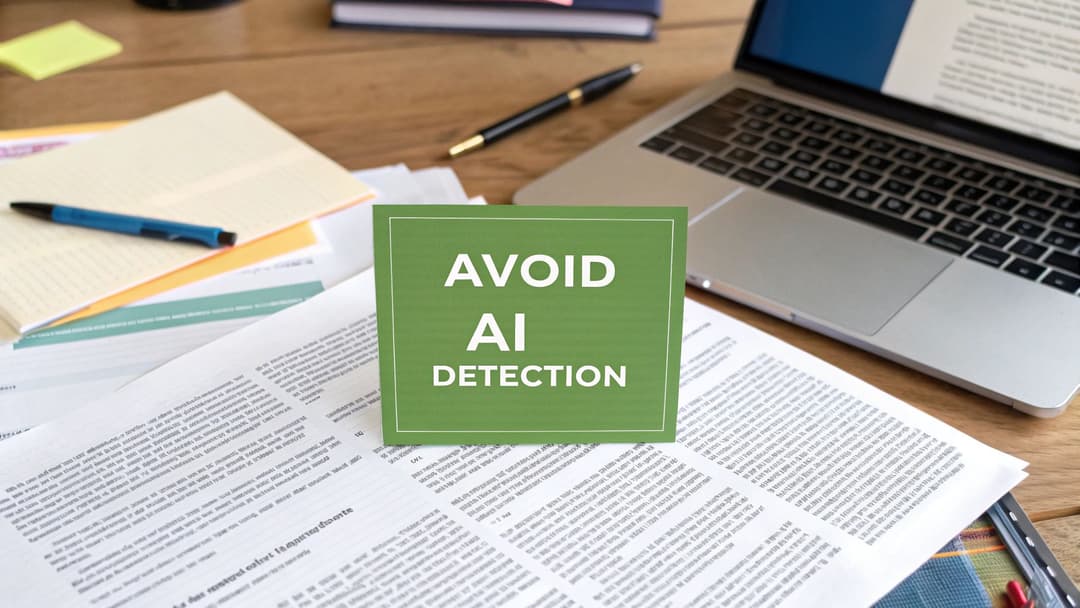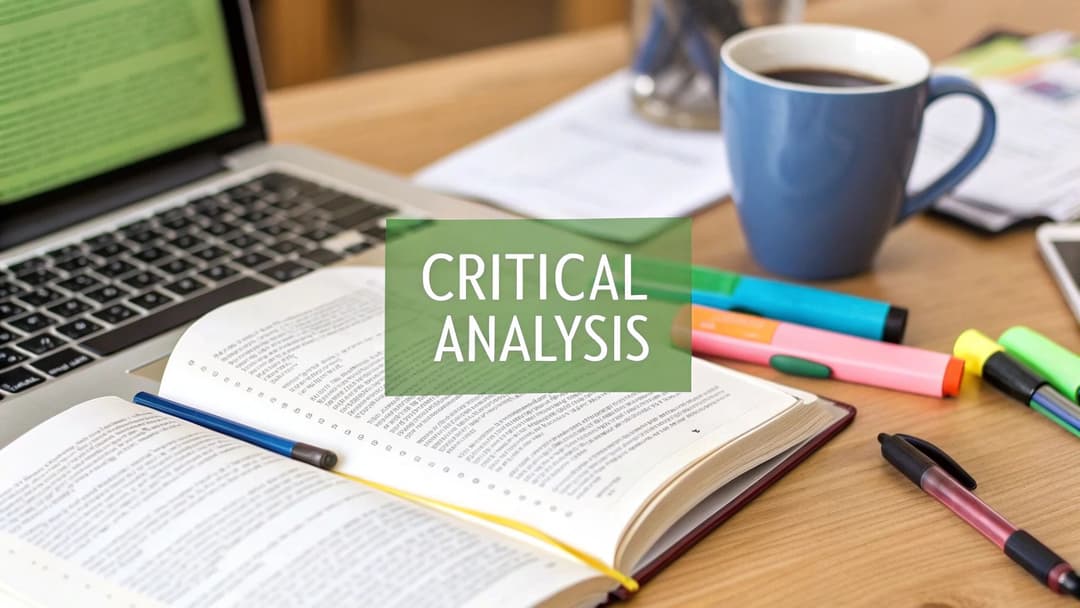
8 Advanced Paraphrasing Techniques for 2025
July 22, 2025
In a world saturated with information and powered by AI writers, the ability to paraphrase effectively is more than an academic skill; it's a critical tool for communication. Simply swapping out a few words isn't enough to avoid plagiarism, humanize robotic text, or convey ideas in your unique voice. True mastery lies in understanding the deeper mechanics of language and meaning.
This guide moves beyond the basics to explore sophisticated paraphrasing techniques that empower you to restructure ideas, shift perspectives, and adapt content for any audience. We will break down eight distinct strategies, from simple synonym replacement to complex conceptual reframing. Whether you are a student aiming for academic integrity, a marketer crafting compelling copy, or a writer refining AI-generated drafts, these methods will transform how you approach rewriting.
Inside, you will find practical, step-by-step instructions for each technique, complete with real-world examples and clear implementation details. The goal is to equip you with a versatile toolkit for any paraphrasing challenge. By mastering these approaches, you will learn to articulate concepts with precision, originality, and confidence, ensuring your message is not only understood but also resonates authentically with your intended reader. This article provides actionable insights to help you move from basic rewording to truly transformative content creation.
1. Synonym Substitution Technique
The synonym substitution technique is often the first method people learn when exploring paraphrasing. At its core, this approach involves replacing individual words and short phrases in the original text with their synonyms, or words with similar meanings. It's a foundational skill that relies on a strong vocabulary and a keen understanding of context.
While straightforward, this method is a crucial building block among paraphrasing techniques. It allows you to quickly alter a sentence's composition without losing its original intent. However, using it in isolation can sometimes result in awkward or unnatural phrasing, making it most effective when combined with more advanced structural changes.
How It Works in Practice
The goal is to swap out key terms-nouns, verbs, adjectives, and adverbs-while preserving the sentence's core message.
- Original: "The study shows significant results that could influence future policy."
- Paraphrased: "The research demonstrates important findings that might affect subsequent regulations."
Here, "study" becomes "research," "shows" becomes "demonstrates," "significant" becomes "important," and "future policy" is rephrased as "subsequent regulations." Each change maintains the original meaning but alters the wording.
A Step-by-Step Process for Effective Substitution
To apply this technique correctly, it's essential to follow a structured process. This ensures that the synonyms you choose fit the context and maintain the text's integrity.
The following infographic outlines a simple three-step workflow for successful synonym substitution.

This workflow highlights the importance of not just finding synonyms, but carefully validating their appropriateness to ensure the paraphrased text remains accurate and coherent.
Key Considerations and Best Practices
To master this technique, move beyond simply swapping words. Consider these tips for a more nuanced approach:
- Verify Context: A thesaurus offers options, but not all are suitable. For example, "big" and "momentous" can be synonyms for "large," but "a momentous rock" sounds strange. Always check that the new word fits the sentence's context.
- Mind the Connotation: Words carry emotional weight. "Thrifty" and "cheap" both describe saving money, but "thrifty" has a positive connotation while "cheap" is often negative. Choose synonyms that align with the intended tone.
- Maintain Formal Register: In academic or professional writing, ensure your synonyms match the required level of formality. Swapping "utilize" for "use" is acceptable, but replacing it with "get ahold of" is not.
When used thoughtfully, synonym substitution is an excellent tool for varying your language and is a fundamental step in avoiding plagiarism. To dive deeper into this topic, you can learn more about techniques for avoiding plagiarism on naturalwrite.com.
2. Structural Reconstruction Method
The Structural Reconstruction Method is one of the more advanced paraphrasing techniques, moving beyond word-level changes to completely reorganize sentence architecture. This approach involves altering the grammatical structure, changing the order of clauses, and reconfiguring how information is presented. It fundamentally transforms the original text while ensuring the core message remains intact.
This technique is a powerful way to demonstrate a deep understanding of the source material. Instead of just swapping words, you are deconstructing and rebuilding the sentences, which results in a truly original piece of writing. This method is particularly effective for academic and professional writing, where demonstrating comprehension is as important as avoiding plagiarism. A practical application is seen in tasks like converting video to blog posts, where spoken narratives are reshaped into written formats, requiring significant structural changes.

How It Works in Practice
The goal here is to manipulate the syntax and flow of the text without losing the original meaning. This often involves converting between active and passive voice or reordering clauses.
- Original: "The experiment was conducted by researchers to test the hypothesis."
- Paraphrased: "Researchers conducted the experiment, testing their hypothesis through this process."
In this example, the sentence is shifted from a passive construction ("was conducted by") to an active one ("Researchers conducted"). This simple change makes the sentence more direct and engaging.
A Step-by-Step Process for Effective Reconstruction
Applying this technique requires a strong grasp of grammar and sentence mechanics. Following a clear process helps maintain logical flow and coherence.
This video from Scribbr offers a clear visual guide on how to restructure sentences for paraphrasing, covering key strategies like changing voice and combining or splitting sentences.
This visual tutorial effectively demonstrates how to apply structural changes to create unique and well-formed sentences while preserving the original intent.
Key Considerations and Best Practices
To effectively use structural reconstruction, focus on the underlying logic of the sentence rather than just the words.
- Switch Between Active and Passive Voice: As shown in the example, changing the voice is a quick way to alter structure. Active voice is often more direct, while passive voice can be useful for emphasizing the action over the actor.
- Vary Sentence Beginnings: Avoid starting every sentence the same way. Begin with a different part of speech, a subordinate clause, or a prepositional phrase to create variety.
- Combine and Split Sentences: Merge short, choppy sentences into a more complex one using conjunctions. Conversely, break down long, convoluted sentences into shorter, clearer ones.
- Maintain Logical Connections: When rearranging clauses and ideas, use transition words (e.g., "however," "therefore," "additionally") to ensure the relationship between concepts remains clear and logical.
Structural reconstruction is a cornerstone of sophisticated writing and revision. For a more comprehensive look at refining your writing, you can use a detailed writing revision checklist to guide your process.
3. Conceptual Abstraction Technique
The conceptual abstraction technique is a sophisticated method that goes beyond surface-level word changes. It involves understanding the core idea or concept of the original text and then expressing it at a different level of generality or specificity. This approach allows for a complete reinterpretation of the information while ensuring the fundamental message remains accurate.
As one of the more advanced paraphrasing techniques, conceptual abstraction requires deep comprehension. Instead of focusing on individual words, you focus on the underlying meaning. This method is exceptionally powerful for transforming complex technical information into more accessible language, or conversely, for elevating simple ideas into more formal or academic statements.
How It Works in Practice
The goal is to move between specific details and general principles. You can either zoom out to a broader concept or zoom in to provide more specific examples that illustrate the same point.
- Original: "Photosynthesis converts sunlight, water, and carbon dioxide into chemical energy in the form of glucose, releasing oxygen as a byproduct."
- Paraphrased (More General): "Plants transform solar radiation into stored energy through a complex biological process."
- Original: "Social media platforms collect user data through cookies and tracking pixels to deliver targeted advertisements."
- Paraphrased (More General): "Digital communication networks gather information about their users' online behaviors through various technological methods to personalize content."
In both cases, the rephrased sentence captures the essence of the original but communicates it from a different conceptual altitude, either broader or more focused.
A Step-by-Step Process for Effective Abstraction
To apply this technique effectively, you need to deconstruct the original idea before you can reconstruct it. This systematic process helps maintain conceptual integrity.
- Identify the Core Concept: Read the original sentence and ask, "What is the fundamental idea being communicated?" Ignore the specific words for a moment and focus on the principle at play.
- Determine the Desired Abstraction Level: Decide if you need to make the concept more general (for a broader audience) or more specific (to provide concrete examples). Your goal and your audience will guide this choice.
- Rephrase Using New Language: Express the core concept at your chosen level of abstraction, using entirely different phrasing. This step often involves using a new sentence structure alongside new vocabulary.
- Verify Conceptual Accuracy: Reread your paraphrased sentence and compare it to the original's core idea. Ensure that you have not distorted the meaning, even though the wording and level of detail have changed.
Key Considerations and Best Practices
Mastering conceptual abstraction requires a blend of analytical and creative thinking. Consider these tips for a more effective application:
- Practice Moving Between Levels: Challenge yourself to take a specific statement and make it general, and vice versa. For example, "The dog barked loudly" could become "The canine vocalized its presence" (more abstract) or "The German Shepherd's deep barks echoed across the yard" (more specific).
- Use Concept Mapping: For complex ideas, sketch a quick concept map or diagram. This visual tool can help you identify the main principle and its supporting details, making it easier to decide which elements to include or generalize.
- Match the Audience's Understanding: The primary reason to change the abstraction level is to better connect with your reader. A general statement works well for an introduction, while specific details are better for a technical explanation.
- Combine with Other Techniques: Conceptual abstraction is most powerful when used with other paraphrasing techniques like structural changes and synonym substitution to create a completely new and original text.
4. Perspective Shifting Method
The perspective shifting method is a sophisticated paraphrasing technique that involves changing the viewpoint or angle from which information is presented. Instead of just altering words or sentence structure, this approach fundamentally reframes the narrative by shifting the focus, such as moving from a passive observation to an active recommendation or from a problem-focused statement to a solution-oriented one.

Popularized in fields like journalism and narrative therapy, this technique excels at making content more relevant or impactful for a specific audience without sacrificing factual accuracy. It is one of the most powerful paraphrasing techniques for transforming not just the language, but the entire feel of the original text.
How It Works in Practice
The goal is to recast the information by changing who or what is the primary subject or focus of the sentence. This can mean shifting from an abstract entity to a human agent or vice versa.
- Original: "The company's profits decreased due to poor management."
- Paraphrased: "Management decisions contributed to the decline in corporate financial performance."
In this example, the perspective shifts from a passive outcome ("profits decreased") to the active agent responsible ("management decisions"). This subtly changes the emphasis from the problem to its source.
A Step-by-Step Process for Effective Shifting
To apply this method effectively, you need to analyze the original statement's point of view and then consciously choose a new one that better serves your purpose.
- Identify the Original Focus: Determine the subject and perspective of the original sentence. Is it focused on an object, a person, a problem, or a result?
- Choose a New Perspective: Consider your audience and goal. Do you want to empower the reader, emphasize a cause, or highlight a solution? Choose a new subject or angle accordingly.
- Rewrite from the New Viewpoint: Reconstruct the sentence to reflect the new perspective, ensuring all key information and facts remain accurate.
This process allows for a deep and meaningful transformation of the text, moving far beyond simple word replacement.
Key Considerations and Best Practices
To master perspective shifting, you must think critically about the message you want to convey. Consider these tips for a more strategic approach:
- Maintain Factual Integrity: This is the most critical rule. Shifting perspective should never involve changing the core facts. The truth of the original statement must be preserved.
- Consider Your Audience: A shift from an academic perspective ("Researchers found...") to a reader-focused one ("You can improve your mood...") makes information more personal and actionable for a general audience.
- Use Shifts for Emphasis: This technique is excellent for drawing attention to specific aspects of the information. You can highlight responsibility, benefits, or consequences simply by changing the narrative focus.
- Combine with Other Techniques: Perspective shifting works exceptionally well when paired with synonym substitution and sentence restructuring for a comprehensive and polished paraphrase.
5. Compression and Expansion Strategy
The compression and expansion strategy is a highly flexible paraphrasing technique that focuses on adjusting information density. At its core, this approach involves either condensing detailed information into a more concise form (compression) or elaborating on brief statements to provide more comprehensive detail (expansion). This method allows writers to tailor content to their specific audience and purpose.
This dual-nature approach is a powerful tool among paraphrasing techniques because it goes beyond simply rewording. It enables you to control the level of detail, making text more accessible for beginners or more thorough for experts. By strategically compressing or expanding, you can manage pacing, emphasize key points, and align the text with your communication goals.
How It Works in Practice
The goal is to either distill a sentence to its essential meaning or build upon a simple idea with additional context and explanation, all while preserving the original intent.
- Compression Example:
- Original: "The comprehensive study involved 500 participants from various demographic backgrounds, including different ages, ethnicities, and socioeconomic levels."
- Paraphrased: "The study included 500 diverse participants."
- Expansion Example:
- Original: "Exercise helps health."
- Paraphrased: "Regular physical activity contributes to improved cardiovascular health, mental well-being, and overall physical fitness."
In the first case, extraneous details are removed for brevity. In the second, a simple statement is enriched with specific examples of health benefits.
Key Considerations and Best Practices
To master this technique, you must balance brevity with clarity and detail with relevance. Consider these tips for a more effective approach:
- Identify Core Information: Before compressing, determine the non-negotiable information that must be preserved. What is the absolute minimum the reader needs to know?
- Consider Your Audience: Are you writing for experts who can fill in the gaps or for newcomers who need more explanation? Adjust your level of detail to match their knowledge.
- Maintain Logical Flow: When expanding, ensure that new details are relevant and logically connected to the main point. Avoid adding information that disrupts the flow or confuses the reader.
- Use Strategically for Emphasis: Compression can make a point feel more direct and impactful. Expansion can be used to underscore the importance or complexity of an idea by dedicating more space to it.
When used thoughtfully, the compression and expansion strategy is an advanced method for reshaping information to perfectly suit your needs.
6. Metaphorical Translation Technique
The metaphorical translation technique offers a creative and sophisticated way to rephrase text. This method involves transforming literal statements into metaphorical ones, or vice versa, to communicate the core idea in a fresh, engaging manner. It is particularly effective for making abstract concepts more relatable or adding evocative depth to simple descriptions.
This advanced approach moves beyond simple word or sentence changes, requiring a deeper conceptual understanding of the text. Popularized by creative writing instructors and science communicators, it is one of the most powerful paraphrasing techniques for capturing an audience's attention and making complex information more memorable.

How It Works in Practice
The goal is to translate the underlying meaning of a sentence into a new form using figurative language or, conversely, by grounding a metaphor in literal terms. This can add a layer of creativity or clarity.
- Original: "The company's new project consumed a large portion of its annual budget."
- Paraphrased: "The company's new project was a voracious beast, devouring a large portion of its annual budget."
Here, the literal idea of resource consumption is transformed into a powerful metaphor. In another example, we can go from figurative to literal:
- Original: "His argument was a house of cards, ready to collapse at the slightest touch."
- Paraphrased: "His argument was structurally unsound and based on weak, interconnected premises that could be easily disproven."
Key Considerations and Best Practices
To use this technique effectively, you need to ensure your metaphors enhance, rather than obscure, the original message. Consider these essential tips for a more impactful result:
- Choose Appropriate Metaphors: The metaphor must resonate with your audience. A sports analogy might work well for a business audience but could be lost on a group of artists. Ensure the comparison is intuitive and relevant.
- Clarify, Don't Confuse: The primary purpose of a good metaphor is to simplify a complex idea or make a simple one more vivid. If your figurative language requires a lengthy explanation, it has failed.
- Avoid Mixed Metaphors: Do not combine conflicting metaphors in a single sentence, such as, "We need to iron out the bottlenecks." This creates confusing and often humorous imagery that undermines your credibility.
- Consider Cultural Context: Figurative language is often culturally specific. An idiom or metaphor that is powerful in one culture may be meaningless or even offensive in another. Be mindful of your audience's background.
7. Logical Reorganization Method
The logical reorganization method is an advanced paraphrasing technique that involves fundamentally altering the structural flow of information. Instead of just changing words or sentence order, this approach restructures the content according to a different logical pattern, such as chronological, spatial, cause-and-effect, or problem-solution. It preserves all the original information but presents it within an entirely new framework.
This systematic technique is particularly powerful for transforming source material into something truly unique. It demonstrates a deep understanding of the content, as you must first identify the original organizational structure before you can effectively remap it. This method moves beyond surface-level changes to reshape the narrative and logic of the text itself.
How It Works in Practice
The goal is to reframe the information by choosing a new organizing principle that better suits your purpose or audience while retaining every key detail.
- Original (Chronological): "First, the team gathered preliminary data. Next, they analyzed the findings. Finally, they published their conclusions in a journal."
- Paraphrased (Problem-Solution): "To address the lack of clear conclusions on the topic, the team initiated a study by gathering preliminary data. Their subsequent analysis of the findings provided the necessary evidence, which they then published in a journal to share the solution."
In this example, the simple chronological sequence is transformed into a narrative about solving a problem, making the information more compelling and purpose-driven.
A Step-by-Step Process for Effective Reorganization
Applying this technique requires a strategic approach to ensure the new structure is coherent and logical. It's more than just shuffling paragraphs; it's about creating a new, sound argument.
- Identify the Original Pattern: First, determine how the source text is organized. Is it a timeline of events, a comparison of two ideas, or an explanation of causes and effects?
- Choose a New Logical Framework: Select a different pattern that enhances understanding or aligns with your goals. For instance, you could change a cause-and-effect explanation into a problem-solution format.
- Remap the Information: Rearrange the original points and details to fit the new structure, ensuring all essential information is included.
- Use Transitional Phrases: Integrate words and phrases like "consequently," "in response to," or "adjacent to this" to guide the reader smoothly through the new logical flow.
Key Considerations and Best Practices
To master this technique, focus on maintaining clarity and coherence throughout the transformation. Consider these tips for a more effective result:
- Ensure All Key Information Is Retained: The primary risk of this method is accidentally omitting crucial details during the restructuring. Double-check your paraphrased version against the original to confirm nothing important was lost.
- Choose a Pattern That Enhances Meaning: Your new structure should serve a purpose. Reorganizing a chronological process into a spatial one might be confusing, but reframing it as a problem-solution can add valuable context and impact.
- Maintain Logical Flow: Without proper transitions, your reorganized text can feel disjointed. Use transitional words and phrases to create clear connections between ideas and ensure the reader can follow your new line of reasoning.
When executed well, logical reorganization is one of the most sophisticated paraphrasing techniques available, allowing you to completely reimagine source material while respecting its original integrity.
8. Register and Tone Adaptation Technique
The register and tone adaptation technique is a sophisticated paraphrasing method that goes beyond changing words and sentence structure. This approach involves modifying the text's formality, style, and emotional tone to align with a specific audience or communication goal, all while preserving the core information. It is a vital skill for anyone looking to make content resonate in different contexts.
This powerful method transforms a single piece of information into a versatile asset. Whether you're simplifying technical jargon for a general audience or elevating a casual statement into a formal report, this technique ensures your message is not just understood but also appropriate and effective. It's one of the more advanced paraphrasing techniques, demanding a strong awareness of audience and purpose.
How It Works in Practice
The goal is to reshape the text's personality without losing its substance. This can mean shifting from a formal to an informal register, a technical to a general style, or an objective to an engaging tone.
- Original (Formal): "The research indicates significant correlations between dietary habits and long-term wellness outcomes."
- Paraphrased (Informal): "The study basically shows that what you eat is really connected to your future health."
Here, the formal language ("indicates," "significant correlations," "wellness outcomes") is replaced with more conversational terms ("shows," "really connected," "future health"), making the content more accessible to a casual reader.
A Step-by-Step Process for Effective Adaptation
To apply this technique correctly, you need to deliberately analyze your audience and the context of your communication. This ensures your stylistic choices are purposeful and effective.
- Define Your Audience and Goal: First, determine who you are writing for and what you want to achieve. Are you informing experts, persuading customers, or educating beginners? Your answer will guide your tonal and register choices.
- Analyze the Original Tone: Identify the style of the source text. Is it academic, technical, objective, or promotional? Understanding its starting point is crucial for knowing how to shift it.
- Rewrite and Refine: Rephrase the text using vocabulary, sentence structures, and a tone that match your target audience. For instance, replace jargon with simpler terms, or change a passive, neutral statement into an active, persuasive one.
- Review for Consistency: Read the paraphrased text to ensure the new tone and register are consistent throughout. A mix of formal and informal language can be jarring and undermine your message's credibility.
Key Considerations and Best Practices
To master this technique, focus on the subtle art of communication rather than just the mechanics of writing. Consider these tips for a more impactful approach:
- Clearly Identify Your Target Audience: The single most important factor is knowing who you're talking to. A technical explanation for engineers will look very different from a product description for consumers.
- Maintain Consistency in the Chosen Register: Once you choose a tone (e.g., professional, friendly, academic), stick with it. Inconsistencies can confuse the reader and make the text feel unprofessional. This is especially important for brands. You can learn more about developing a consistent brand voice on naturalwrite.com.
- Preserve Essential Information: The core facts, data, and meaning of the original text must remain intact. Stylistic changes should never distort the fundamental message.
- Consider Context Appropriateness: An enthusiastic, engaging tone might be perfect for a blog post but completely out of place in a scientific paper or a legal document. Always match the tone to the context.
Paraphrasing Techniques Comparison Matrix
| Technique | Implementation Complexity 🔄 | Resource Requirements ⚡ | Expected Outcomes 📊 | Ideal Use Cases 💡 | Key Advantages ⭐ |
|---|---|---|---|---|---|
| Synonym Substitution Technique | Low - basic vocabulary and context skills | Low - mainly thesaurus and attention | Moderate - simple paraphrasing, risk of awkwardness | Quick, basic paraphrasing; vocabulary building | Easy, fast, builds vocabulary |
| Structural Reconstruction Method | High - advanced grammar and restructuring | Medium - time and grammar knowledge | High - substantially different structure, improved style | Academic writing, plagiarism reduction | Creates variety, reduces plagiarism risk |
| Conceptual Abstraction Technique | Very High - deep subject comprehension | High - extensive knowledge and creativity | Very High - original content, sophisticated interpretation | Complex academic content, conceptual discussion | Highly original, demonstrates depth |
| Perspective Shifting Method | Medium - attentive viewpoint changes | Medium - careful accuracy and balance | High - fresh presentation, varied emphasis | Persuasive writing, engaging narratives | Engaging, fresh, emphasizes different aspects |
| Compression and Expansion Strategy | Medium - judging info density and flow | Medium - content analysis and adaptation | Moderate to High - tailored length and clarity | Summarization, content marketing, education | Adaptable, clarifies or expands content |
| Metaphorical Translation Technique | High - creative and cultural sensitivity | Medium to High - creativity and cultural knowledge | High - improved engagement and memorability | Creative writing, science communication | Enhances accessibility, creativity |
| Logical Reorganization Method | High - logical structuring and transitions | Medium - understanding of frameworks | High - clearer, better-organized content | Technical documents, educational materials | Improves clarity and reader comprehension |
| Register and Tone Adaptation Technique | Medium to High - nuanced language control | Medium - strong language awareness | High - audience-tailored tone and style | Multi-platform content, business, ESL teaching | Increases accessibility, engagement |
Integrating Techniques for Effortless, Human-Centric Writing
Throughout this guide, we have explored a comprehensive suite of eight distinct paraphrasing techniques, moving from foundational methods like Synonym Substitution to advanced strategies such as Conceptual Abstraction and Metaphorical Translation. You have seen how each approach offers a unique way to reinterpret, refine, and reinvigorate text. However, the true artistry of paraphrasing lies not in mastering these techniques in isolation, but in learning how to weave them together into a seamless, integrated workflow.
Effective writing is rarely a linear process. You might begin with the Structural Reconstruction Method to fundamentally alter a sentence's architecture, then layer in the Compression and Expansion Strategy to adjust its length and impact for a specific medium. Finally, you could apply the Register and Tone Adaptation Technique to ensure the language aligns perfectly with your target audience, whether they are academic peers or social media followers. This dynamic combination is what elevates paraphrasing from a simple anti-plagiarism measure to a sophisticated tool for crafting clear, original, and impactful communication.
From Technical Skill to Creative Expression
Think of these paraphrasing techniques as a musician’s scales. At first, you practice each one individually to build muscle memory and understanding. But eventually, you combine them to create a unique melody. This is your goal: to internalize these methods so deeply that you can apply them instinctively, blending them to serve the ultimate purpose of your message.
The journey looks something like this:
- Initial Draft: You start with an original source, a clunky AI-generated paragraph, or your own rough idea.
- Structural Rework: You apply techniques like Structural Reconstruction or Logical Reorganization to create a new foundation.
- Conceptual Refinement: You use Conceptual Abstraction or the Perspective Shifting Method to articulate the core idea in a genuinely new way.
- Stylistic Polish: You fine-tune word choices with Synonym Substitution, add creative flair with Metaphorical Translation, and finalize the voice using Tone Adaptation.
By approaching your writing this way, you move beyond merely restating information. You are actively interpreting, analyzing, and re-presenting ideas with your own unique intellectual and creative signature.
The Human Advantage in an AI-Powered World
In an era where AI can generate text in seconds, the value of human-centric writing has never been higher. AI-produced content often carries tell-tale signs: a lack of emotional nuance, a repetitive sentence structure, and a generic, homogenized tone. This is where your mastery of these paraphrasing techniques becomes a critical professional advantage. You can use them to transform robotic, sterile drafts into content that feels authentic, relatable, and trustworthy. For those looking to apply these methods with modern assistance, exploring the top AI paraphrasing tools can significantly streamline the process, helping you find a co-pilot that complements your human skills rather than replacing them.
Ultimately, the goal is not to "beat" AI, but to collaborate with it intelligently. Use AI for its speed and ability to generate initial frameworks, then apply your nuanced human understanding to infuse the text with personality, empathy, and strategic purpose. This hybrid approach allows you to produce high-quality content at scale without sacrificing the essential human element that builds true connection with an audience. By mastering these skills, you are future-proofing your value as a writer, communicator, and thinker. You are not just rearranging words; you are shaping meaning, building authority, and ensuring your voice is heard with clarity and originality.
Ready to elevate your writing from good to exceptional? Natural Write is designed to help you apply these advanced paraphrasing principles effortlessly. Our tool helps you humanize AI-generated text, refine your tone, and improve clarity, ensuring your work is original and engaging. Try Natural Write today and transform your writing process.


